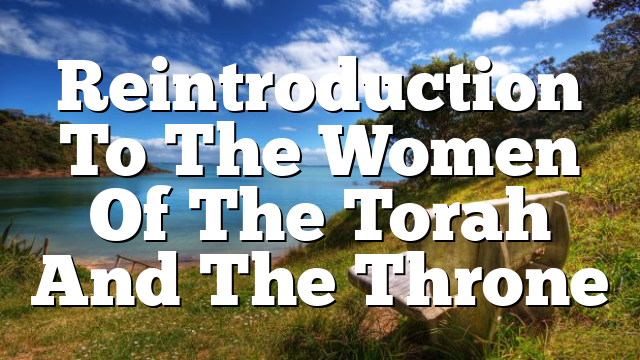Click to join the conversation with over 500,000 Pentecostal believers and scholars
Click to get our FREE MOBILE APP and stay connected
| PentecostalTheology.com



Book Reviews
613
Wilda C. Gafney,Womanist Midrash: A Reintroduction to the Women of the Torah
and the Throne(Louisville,KY: Westminster John Knox Press, 2017). 340 pp. $35.00
paperback.
Wilda C. Gafney begins her book with what may be the most welcoming pro- logue I have ever read. She invites us, her readers, to supper. Her welcome is an embodiment of womanism marked by the generous hospitality of a gracious host. She sets the tone with her epistemology of abundance and sharing in contrast to patriarchal models of hierarchy and scarcity, “Don’t worry, it’s no trouble, there’s plenty to eat, and there are extra places at the table. Help your- self” (1). This warm womanist welcome immediately invites the reader to put their guards down and just enjoy what she is about to offer. This is not a table of scarcity or a table where one needs to prove they belong. The invitation is in itself womanism lived out.
Gafney defines womanism as black feminism (6). Like feminism, it shares an egalitarian commitment, but unlike feminism, it is not centered on the experi- ence of white women who often ignore the intersectional dilemmas of women of color. Womanist theology is concerned with not only issues of gender, but also class, race, and sexuality. She uses this lens with a bit of the African Amer- ican homiletic tradition of preacher-interpreter “sanctified imagination” (3) to approach the ancient Hebrew texts. She approaches the Hebrew texts with wonderful womanist ingredients; “womanish” sensibilities that portray a girl- grown-up maturity and a love of women (including herself) and all that she is and creates.
The book is divided into two parts, Women of the Torah and Women of the Throne. Within those two parts she does something so unique, it’s worth read- ing the book for this alone; she names the women in the Old Testament. There are other books that may name a couple major figures like Esther and Ruth, but this book names the women who are not as recognizable. Gafney brings to centerstage, the named and unnamed women of the Old Testament. This is a powerful, womanist course of action. Many women of color often feel the bur- den of being ignored, dismissed, or unseen. By naming the women in the Old Testament, Gafney says, “I see you, ancient sister, and I’d like to introduce you to my readers.” Naming the women brings them to the forefront of the read- ers’ mind. They are no longer obscure props in stories about men—they are humans that deserve attention in their own right.
Gafney then takes each woman, exegetes the passage, and then uses her sanctified imagination to bring the ancient text to the contemporary world of African American women. For instance, while discussing the situation of Sarai and Abram, Gafney states, “A hip-hop womanist reading of this text would say
PNEUMA
© koninklijke brill nv, leiden, 2018 | doi:10.1163/15700747-04004014
1
614
Book Reviews
that he pimped her out” (33). The reader might initially chuckle at the con- nection, but then nod at the truth of the connection. Gafney deftly takes the reader from the Torah to contemporary analogies to historical accounts of rape and enslavement of African women and then back to the text with each story.
Rarely recognized women become case studies for much larger cultural concerns. In discussing Bilhah’s sexual subordination in the book of Genesis, Gafney points to the sexual abuse of enslaved Africans in the United States and other countries (67). This move brings the reader closer to the context of the book of Genesis, while alerting them to the continued practice of abuse thou- sands of years later. She goes further however by bringing the reader’s attention to the world in, before, and behind the text (73).
It is extraordinary that the Hebrew Scriptures, which do not shy away from sexually explicit and violent stories, do not acknowledge the sys- temic nature of sexual abuse of enslaved persons in its accounts of Egyp- tian slavery.
73
Here we see Gafney delve deeper into the differences ways in which women were mistreated. There were justifications for foreigners since their worship practices were different and wrong. But what about enslaving the women in one’s own community who worshiped the “right” way? These are the questions, Gafney explores.
Gafney’s method is clear, consistent, and fearless. She names the names, describes the atrocities, and parallels them to the stories of countless black women subjugated to the same violence as their ancient sisters. It is unclear why she leaves out the major women of the Old Testament such as Esther and Ruth, but that may also be because she seeks to uncover the untold stories. Esther and Ruth’s stories have already been told. But because Gafney does such a painstaking work to uncover those untold stories, it leaves one wanting to hear more about the better-known Old Testament women.
It may start to feel redundant throughout the book as one finds themes of rape, sexual abuse, violence, subordination, and slavery in the passages. It is. But it is also the reality of women throughout history. These issues persist throughout the biblical texts as they persist throughout the world today. The redundancy of themes seems to embody how tiring it becomes for women of color to experience such objectification from generation to generation.
This book is an excellentaddition toan OldTestament,hermeneutics,or the- ology syllabus. It offers a rarely considered, but vitally needed, hermeneutical framework.Womanism is often considered “contextual” theology, but as all the-
PNEUMA 40 (2018) 563–624
2
Book Reviews
615
ology is contextual in some way this book should be used as a staple in teaching students exegetical methodology. Gafney’s midrash, or exegesis, offers readers from all backgrounds a new tool for how to connect the cultural and biblical context to contemporary cultural contexts.
For those who are used to and comfortable with white male exegesis, her approach may feel suspicious, but the reality is, it’s just different from what has often been taught in academia. The womanist midrash, invites readers to see women who have often gone unseen under the male gaze, hear their sto- ries, and consider who else in the contemporary world might also be unseen. Through this method, Gafney takes great care to make sure her exegesis is in line with the standards of other biblical scholars, but she is also committed to sharing her food, her way and all are welcomed to the table.
Joyce del Rosario
Fuller Theological Seminary, Pasadena, California joycedelrosario@fuller.edu
PNEUMA 40 (2018) 563–624
3


